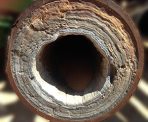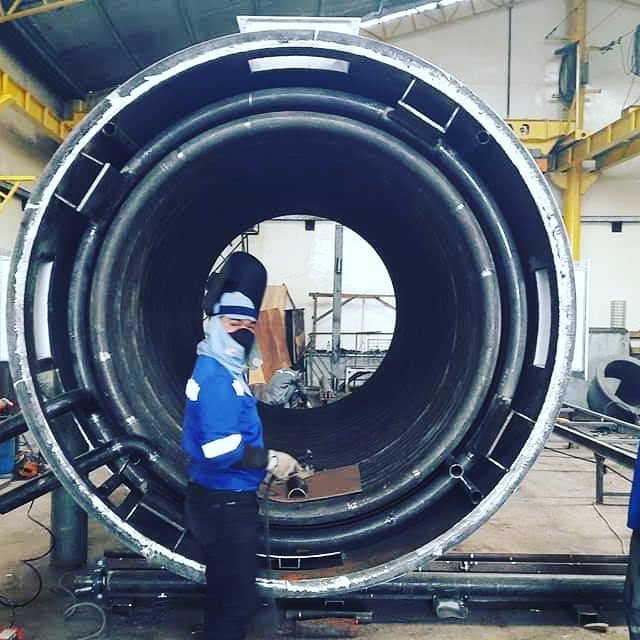Boiler Water Treatment
Boilers or steam boilers are devices used to produce steam / pressurized steam, by heating water using fuel oil, coal or by-products, where steam functions to heat, run turbines or produce energy in an industry.
Common problems with boilers include corrosion, scale, sludge and carryover steam. The four things if this happens will reduce boiler efficiency and will endanger both the system / industrial equipment and the work environment.
Prevention of problems is not enough if only through an external treatment process, therefore an internal treatment or boiler maintenance process is required using chemicals.
The following is a description of the problems that often occur in boiler systems:
- Corrosion
 Corrosion is a major problem that occurs in boilers that operate at high temperatures and pressures. Corrosion can occur and accelerate with a low pH environment, high dissolved oxygen content and carbon dioxide in feed water.
Corrosion is a major problem that occurs in boilers that operate at high temperatures and pressures. Corrosion can occur and accelerate with a low pH environment, high dissolved oxygen content and carbon dioxide in feed water.
2. Crust
 Minerals that are concentrated in the boiler can result in the formation of deposits that can be attached to water tubes and boiler drums. Hardness that passes to the boiler due to not optimal work of the softener unit or demin unit can react with silica or carbonate in the water to form a deposit.
Minerals that are concentrated in the boiler can result in the formation of deposits that can be attached to water tubes and boiler drums. Hardness that passes to the boiler due to not optimal work of the softener unit or demin unit can react with silica or carbonate in the water to form a deposit.
Generally the crust composition on the boiler pipe can be distinguished from its constituent material, for example as below:
a. Crust Calcium carbonate / calcium carbonate (CaCO3).
Formed from the breakdown of hardness from the softener / demin unit into the boiler, with the influence of high alkalinity and temperature. Prevention can be done by controlling the quality of boiler feed water, the frequency of proper resin regeneration, adding phosphate material to boiler water or other scale prevention compounds such as tanin and polymer dispersants.
b. Calcium silicate crust – Magnesium Silicate
Formed due to the high concentration of boiler water, the breakdown of hardness is accompanied by solubility of silica in boiler water that is exceeded (saturated) in the atmosphere of the boiler pH which is quite low (pH <9). Prevention is to maintain the concentration of Silica in the prescribed standards (according to boiler capacity and pressure), keeping O-Alkalinity 2.5 x from the silica content.
O-Alkalinity = (2P-Alkalinity) – M Alkalinity.
3. Sludge (mud)
The mud in the boiler in the header or attached to the inner surface of the boiler can be caused by minerals or dissolved solids that accumulate during the boiler operation.
The escape of hardness to the boiler which will react with phosphate residue in boiler water can also form calcium hydroxyapatite soft mud.
Continuous blow down or maintaining dissolved solids (TDS) at the control standards, coupled with the use of dispersant chemicals can prevent the accumulation of mud in the boiler.
4. Carryover
Carryover is the carrying of contaminants or impurities into steam, this can occur if there is foaming due to the high content of TDS, pH, Alkalinity accompanied by oil and certain organic materials in the boiler water. Keeping the boiler concentrated along with anti-foaming chemicals can prevent the foaming problem. Carryover can also occur due to the load or the capacity of the steam produced to increase suddenly (sudden increase in feed water flow).
From the above explanation, it can be concluded that the main purpose of treating boiler water is to prevent crust, rust , accumulation of sludge / mud and carry over.
How to prevent it?
-
External treatment.
This water treatment starts from the process of purification and filtration of raw water, including coagulation, flocculation, pH adjustment, sedimentation, filtration using sand filters, activated carbon, ion exchange resins (softening / demineralization), economizers, deaerators etc.
2. Chemically internal treatment.
This processing uses crust preventive chemicals made from phosphate, tannin, etc., anti-rust, pH enhancer and sludge dispersant (sludge dispersion) ..
